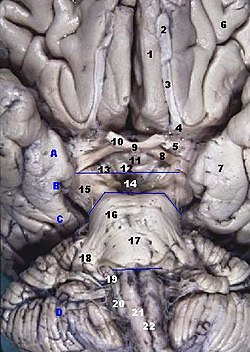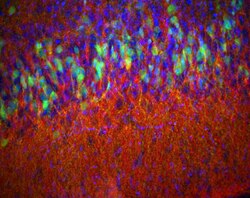Piriform cortex
| Piriform cortex | |
|---|---|
 Human brainstem anterior (piriform cortex not labeled, but most of it is visible near #7) | |
| Details | |
| Identifiers | |
| Latin | cortex piriformis |
| MeSH | D066195 |
| NeuroNames | 165 |
| NeuroLex ID | birnlex_1097 |
| FMA | 62484 |
| Anatomical terms of neuroanatomy | |
The piriform cortex, or pyriform cortex, is a region in the
Structure
The piriform cortex is part of the rhinencephalon situated in the cerebrum.
In human anatomy, the piriform cortex has been described as consisting of the cortical amygdala, uncus, and anterior parahippocampal gyrus.[1] More specifically, the human piriform cortex is located between the insula and the temporal lobe, anteriorly and laterally of the amygdala.[2][3]
Function
The function of the piriform cortex relates to
The piriform cortex in rodents and some primates has been shown to harbor cells expressing markers of plasticity such as doublecortin and PSA-NCAM which are modulated by the noradrenergic neurotransmitter system.[4][5]
Clinical significance
The piriform cortex contains a critical, functionally defined epileptogenic trigger zone, "Area Tempestas".[6] From this site in piriform cortex chemical and electrically evoked seizures can be triggered. It is the site of action for the proconvulsant action of chemoconvulsants.[7]
Other animals

Sometimes called the olfactory cortex, olfactory lobe or paleopallium, piriform cortical regions are present in the brains of
.The piriform cortex is among three areas that emerge in the
As mammalian brains developed, volume of the dorsal cortex increased in slightly greater proportion, as compared proportionally with increased overall brain volume, until it enveloped the
Among
See also
References
- ISBN 978-1-4160-3445-2.
- ^ a b Howard, J. D., Plailly, J., Grueschow, M., Haynes, J. D., & Gottfried, J. A. (2009). Odor quality coding and categorization in human posterior piriform cortex. Nature neuroscience, 12(7), 932-938. Supplementary material, p.4
- ^ Mai, J. K. & Paxinos, G. (2008). Atlas of the human brain, 3rd edition. San Diego:: Academic Press. Coronal Atlas – Plate 8 (anterior view). online: http://www.thehumanbrain.info/head_brain/hn_horizontal_atlas/horizontal.html
- PMID 29289719.
- PMID 28237805.
- PMID 4058572.
- PMID 9015822.
